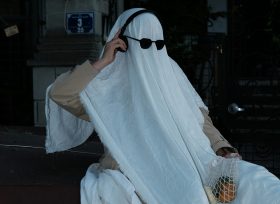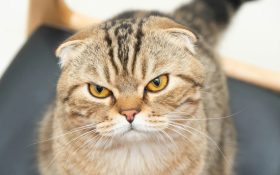Did you grow up with Dr Seuss? Who remembers his ‘Green Eggs and Ham’ and ‘The Cat in The Hat’? Of course there was more to Theodore Seuss than these oddly named children’s books. London will be hosting a retrospective to Dr Seuss in October to celebrate the 100th anniversary of the great man. And Arts Hub’s Ali Howarth speaks to Bill Dreyer, curator of this exhibition that examines the cultural legacy of an American icon.
March 2004 marked the 100th anniversary of the birth of Theodore ‘Ted’ Seuss Geisel. He was of German-American descent and known better to his readers by his penname, Dr Seuss. He authored and illustrated over 40 published titles for children between 1937 and 1991. He won a best cartoon Oscar in 1951 for Gerald McBoing-Boing, a Pulitzer Prize in 1984 and Matt Groening, creator of cult comedy The Simpsons, has described his work as an inspiration.
In 1955 a book by Rudolph Fleisch and an article by John Hersey, both entitled Why Johnny Can’t Read, criticised existing children’s first texts, so-called ‘primers’, as boring and ‘antiseptic’. John Hersey as an example of what could be done better, cited Dr Seuss’ illustrations, he said of his work that it served to: “widen rather than narrow the associative richness the children give to the words”.
As a result, his first big success: The Cat In The Hat was commissioned and published. At first schools were a little hesitant to accept the book but children and parents loved it. The hesitancy no doubt stems from the fact that Dr Seuss’ style was startlingly different from the traditional children’s primers of the day. However, underneath the seeming anarchy of the rhymes is also a loud and clear moral message. Michael Rosen in the Guardian (April 10th 2004) sums up this moral tone as:
‘…an old-fashioned wish to make children better: to encourage them to avoid picking on people because they’re different or weaker and to discourage them from thinking that it’s OK to say or think that you’re superior to someone else.’
The impact of his style on children’s literature was revolutionary and a resurgence in the popularity of his books for children has been ably assisted by Hollywood in recent years – The Cat In The Hat and The Grinch. However, it is the lesser-known artworks that have been spotlighted in the current touring retrospective.
‘The Art of Dr Seuss’ draws together previously unseen art material from the Dr. Seuss Estate, the Lyndon Baines Johnson Presidential Library, the Dr. Seuss archives at the University of California, San Diego, The Henderson Collection, The Charles Cohen Collection, and The Bernard Collection. This work reflects the personal thoughts, ideas and imagery that Ted would not allow in the children’s books. The Chase Group, which enjoys an exclusive relationship with Dr Seuss Enterprises, is presenting the exhibition to include:
The Chase Group’s excellent website has details of some of the paintings to be shown and explains what to expect from the works:
‘These fantastical images have the inimitable style of Geisel’s alter ego Dr. Seuss, frequently depicting outlandish creatures in otherworldly settings. The puckish Seuss humour is in evidence, as well as the insight that often gave his stories deeper meaning. But these paintings break new ground, using a dazzling rainbow of hues not seen in the primary colour palette of Geisel’s books for children.’
The paintings have been taken from the whole range of Geisel’s lifetime and will appeal to existing Seuss fans of all ages, but it is the adult and art-collecting public at whom this new exhibition is aiming. I asked Bill Dreyer, The Chase Group curator, about the cultural context of Geisel’s work:
‘The Dada movement came to New York shortly after he moved there in his twenties. Abstract Expressionism was the rage during the 1950’s and you see him attempting artistically, whatever is going on culturally or aesthetically at the time. We see abstract, Dadaist, and representational artworks in his oeuvre. One of the few direct influences to be discerned seems to be that of M.C. Escher.’
Geisel often spoke of his frustration when critics referred to his writing or illustrations as ‘whimsical’; he believed that the art critics did not take his work seriously. He never attempted to sell his ‘Secret Art’ paintings through fear of rejection by the critics. I asked Bill Dreyer if Ted’s circumspection was warranted and what it was that the critics were missing.
‘One can imagine how his seemingly whimsical paintings and sculpture would have been reviewed by the art elite at the time. As a contemporary of Norman Rockwell, Ted Geisel was aware that commercial artists weren’t considered fine artists. He was probably accurate in believing his artwork wouldn’t be judged well by the art establishment…the element of time, perspective and context were missing. To look at a few paintings of cats or any of his artworks outside the context of what he created throughout a life time couldn’t possibly have been perceived as well as it can when it’s considered as a body of work’.
Whilst Geisel’s widow, Audrey has admitted the irony of the fact that Ted was not overly fond of children, he was clearly a big fan of cats. In this exhibition you are able to enjoy many of his most delightful feline-themed paintings; notably, the gorgeously elongated energy of Alley Cat for a Very Long Alley, the chic Italian cats celebrating his joint loves of Venice and cats in Oh Solo Meow and Cat Carnival in West Venice and the unforgettably hip pool shark cat in Cat From the Wrong Side of the Tracks.
Cats aside, the works featured in this exhibition are unarguably eccentric, fantastical and mischievous. And that’s a good thing. Let’s hope it would comfort the critic-wary Ted Geisel to know that his work is not only commercially sought by the collectors but also hangs in major museums and art galleries alongside Rembrandt, Picasso and Miro.
With thanks to Bill Dreyer. ‘The Art of Dr Seuss’, will be exhibited at the Animation Art Gallery in London from 23rd –31st October 2004 with some works remaining throughout November. For further information on the exhibition and on Dr Seuss see:




